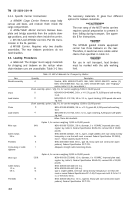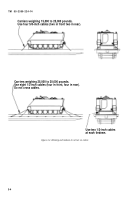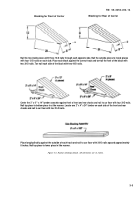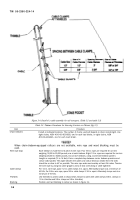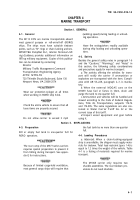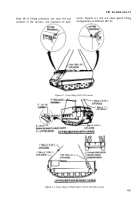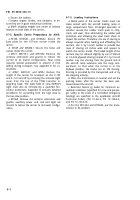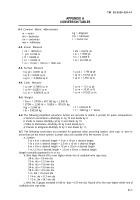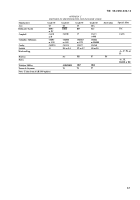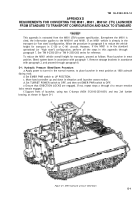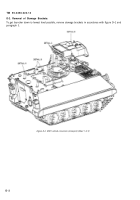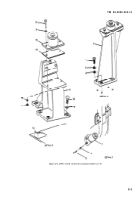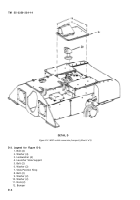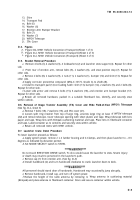TM-55-2350-224-14 - Page 42 of 57
TM 55-2350-224-14
CHAPTER 5
AIR TRANSPORT
Section I. GENERAL
5-1. General
The carriers are air transportable aboard C-130,
C–141, and C-5 aircraft. The shipping unit must
ensure that the carriers are properly prepared for
air transport before reaching the marshaling area.
The shipping unit will assist the aircraft load-
master/crew in loading and tying down the carri-
ers. The loadmaster-prepared load plan for the
actual aircraft mission will have determined load-
ing limitations, tiedown patterns, and troop seat-
ing availability.
Only the M106A1, M113, M113A1, and
M667 are capable of LAPES operations.
Only the M113, M113A1, and M667 are
capable of LVAD.
5-2. Safety
Besides the general safety notes in paragraph 1-6
and the “Caution,” “Warnings,” and “Notes” in
Section Il. TRANSPORT
5-4. USAF Cargo Aircraft
The carriers are certified for airlift aboard C-130,
C-141, and C-5 aircraft. Total load restraint is
three times the carrier weight in the forward
direction (relative to the aircraft) and 1 1/2 times its
weight in the aft and lateral directions. Vertical
load restraint is equal to two times the carrier
weight.
this section, the following safety considerations
and precautions apply for air transport:
a.
Personnel must wear ear protection (plugs) at
all times while working on the flightline.
b.
Fire extinguishers must be readily available
during aircraft loading and unloading operations.
c.
The vehicle maximum speed within 25 feet of
any aircraft is 5 mph. On loading ramps or inside
the aircraft, the vehicle should not exceed 3 mph.
d.
Personnel must not refuel or otherwise ser-
vice the carriers within 50 feet of an aircraft.
e.
The fuel tanks of the flamethrower weapon
system mounted in the M132 and M132A1 must
be emptied and purged as indicated in paragraph
4-2b.
5-3. Dangerous Materials
Shippers must provide written notification before
shipping dangerous or hazardous materials aboard
military or DOD contract aircraft. Details are
covered in TM 38–250/AFR 71–4,
Preparation of
Hazardous Materials for Military Air Shipment,
and CFR 49.
BY CARGO AIRCRAFT
The carriers are air transportable aboard C-17
aircraft. When the C–17 is operational, the USAF
will certify the carriers for air transport aboard
the aircraft.
For preliminary planning purposes only, table 5-1
gives maximum payload dimensions and weight
characteristics. In addition, walking and tiedown
space must also be allowed for.
Table 5–1. Aircraft Cargo Dimensional and Maximum Weight Limits
Aircraft
Height (in.)
Width (in.)
Length (in.)
Weight (lb)
C-130
102
107
480
44,800
C-141
103
111
1,090
68,600
C-5
156
216
1,454
291,000
C-17
142
204
812
172,200
5-5. U.S. Army Aircraft
The carriers exceed size and weight limitations for
transport by U.S. Army fixed-wing aircraft, The
carrier also exceed size limitations for internal
transport and weight limitations for external lift
by U.S. Army rotary-wing aircraft.
5-6. Civil Reserve Air Fleet (CRAF)
The carrier exceeds the height and/or width char-
acteristics of all aircraft in the CRAF.
5-7. Preparation
5–7–1. General Preparations:
a.
Empty fuel tank to three-quarters full.
b.
Secure all loose items inside the carrier.
c. Remove all trash and mud from the carrier’s
tracks.
d.
Check for fluid leaks and repair defects.
5-1
Back to Top


